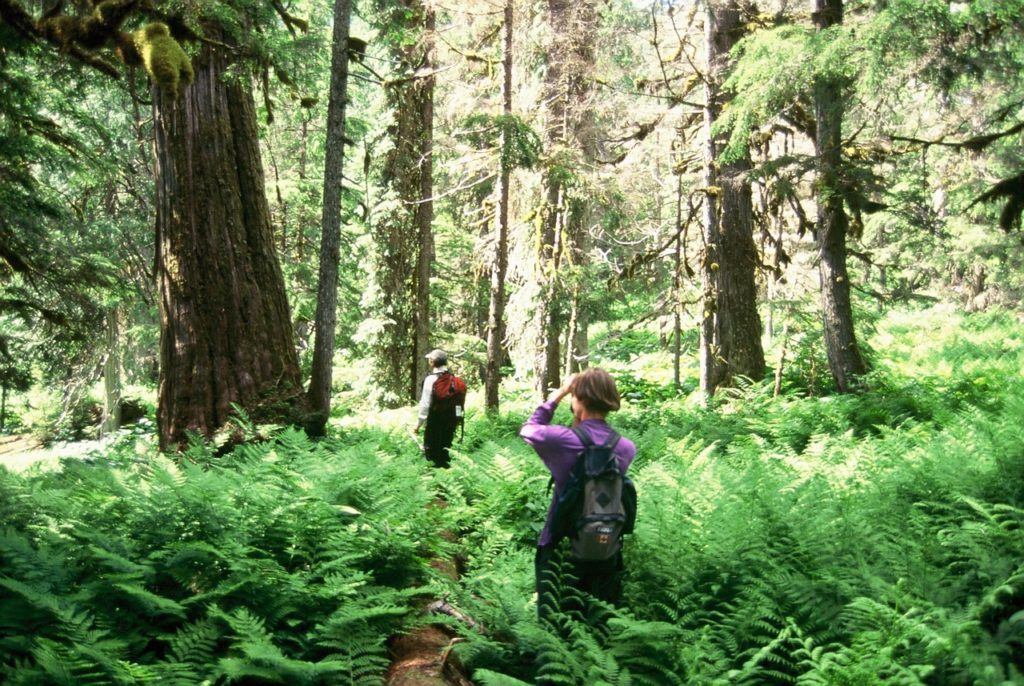
By 2031, after a decade of ever-increasing impacts on society due the rapidly warming climate, it became incumbent upon all levels of government to change how management of the land is managed, which includes water, soils, biodiversity and forests.
The next decade was a transition period, as decision-making shifted to local communities rather than distant bureaucrats. The main goals for forestry became carbon sequestration, watershed protection and ecosystem health, rather than lumber and fibre. Forest exploitation ended and there was a social consensus to conserve and expand forests to help mitigate climate change.
The loss of lives and homes to wildfires prompted intensive forest management near communities that includes development of fire-resistant stands and conversion of coniferous forests to ones mixed with deciduous trees. While electric powered machinery does much of the work, the Canada’s Earth Corps, staffed by young people as part of their education and public service, handle most of the physical work.
While the number of fires continued to increase, the damage to property decreased as fire control became a high priority. Wildfires are now extinguished quickly thanks to high-tech satellite detection, locally stationed aircraft, drones and Earth Corps firefighters.
Key to this success is the contribution that improved water management has made. Nearly every creek in the region has a series of run of the river reservoirs that capture the spring run-off, which varies greatly due to climate instability. In addition to fire control, the stored water is used for human consumption, agriculture and aquaculture.
Adaptation efforts include intensive field-based inventory work, as well as regular monitoring of forest conditions. Forest steward professionals follow comprehensive ecosystem-based standards to protect and restore ecological integrity and live in the communities close to forests they manage. Extra attention is given to watershed management to meet community water needs and to help prevent flooding and landslides. Silviculture practices ensure that burnt areas are protected from damage by salvage logging and replanted as soon as possible with native trees suited to the higher temperatures and long droughts caused by the climate crisis.
Local management means that decisions are made by both Indigenous and local communities, while conforming to comprehensive, ecosystem-based standards. The overall goal is for forests to grow as long as possible under unevened-aged, mixed species management, to nurture healthy forests that absorb the most carbon dioxide, while developing systems to better cope with more diseases and pests.
The only timber that is harvested comes from ecological restoration activities and thinning for fire resistance. All timber is all used locally for construction, with any excess shipped within the province. In a few decades, the mixed species forests will provide options for small scale extraction of both coniferous and deciduous trees ready for harvest, using innovative processing systems.
Some forests are also managed for food production using ancient Indigenous techniques. Berries, mushrooms and some native plants are harvested to augment local agriculture.
As the sea level rose and flooded coastal areas, including large cities, people were forced to move from coastal areas to the interior of the province. In order to accommodate the increased demand for housing, tracts of suitable crown land were opened up for development and logging roads were upgraded to provide access for new communities.
In recognition that climate change mitigation must include protecting biodiversity, intensive community led ecosystem-based conservation planning identified networks of land and aquatic areas that are protected for water conservation, wildlife habitat, cultural activities and/or recreational use.
With air-travel restrictions in place throughout the world, vacationing within the Shuswap became the norm given there are so many options for carbon-free recreation. More trails were built throughout the Shuswap, including some that provided options for multi-day hiking and biking trips.
The overall goal for land management in 2052 is to conserve, restore and protect biodiversity, water, soil and healthy natural forests, all in an effort to promote resiliency. As well, efforts are increasing to better understand the rapid changes that are unfolding as the planet continues to heat up. With extreme weather events now the norm, there is an urgency to develop new ways to assist forest to adapt and develop technologies and systems to prepare for and cope with what is expected to be a far more intense and life-threatening future climate.
POSTSCRIPT
This is the third column in the series called What does the future hold., that imagines what the Shuswap will be like in 30 years under the best case scenario. The next column will be about agriculture, with future columns about infrastructure, housing, education and social life.






